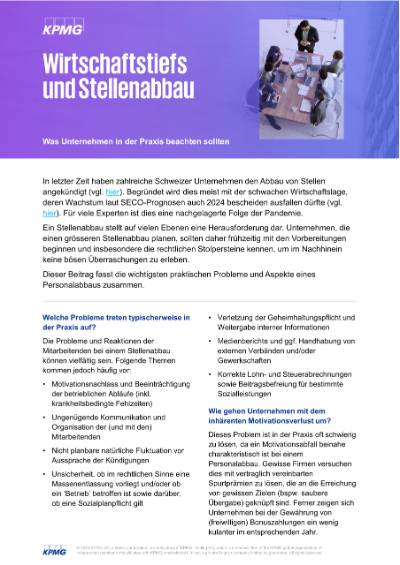Der Erfolg eines Unternehmens hängt massgeblich von dessen Mitarbeitenden ab. Jüngste rechtliche Entwicklungen, neue Arbeitsmodelle, globale Mobilität, die veränderten Bedürfnisse der Mitarbeitenden sowie innovative Beteiligungspläne stellen viele Arbeitgeber vor komplexe juristische Herausforderungen – besonders im internationalen Kontext.
Für Unternehmen bedeutet dies heutzutage mehr als die blosse Einhaltung von Gesetzen und Vorschriften, wie in Bezug auf Arbeitsverträge, Reglemente und Kündigungsfälle; sie müssen vielmehr die Bedürfnisse ihrer internationalen, diversen und qualifizierten Belegschaft berücksichtigen, um attraktive Anstellungsbedingungen zu gewährleisten, Anreize zu schaffen und talentierte Mitarbeitende zu sichern.
KPMG Law Schweiz unterstützt Sie gerne in diesem dynamischen Umfeld, sei es als Arbeitgeber oder als Arbeitnehmer.

Momentan erleben wir eine steigende Nachfrage nach unseren HR-Due-Diligence-Dienstleistungen. Viele Käufer legen immer mehr Wert auf die Menschen, die hinter einem Unternehmen stehen, und möchten insbesondere eine HR Due Diligence durchführen.

KPMG Law
Arbeitsrecht und Kollektivarbeitsrecht
Welche zwingenden Regeln des Arbeitsrechts und Kollektivarbeitsrechts gelten in der Schweiz? Welche Kündigungsschutzbestimmungen gibt es? Sind Konkurrenzverbote in der Schweiz durchsetzbar? Und wie sehen die Überstunden- und Mindestlohnregelungen aus?
Unsere Anwälte für Arbeitsrecht und Kollektivarbeitsrecht können Ihnen diese und weitere Fragen zu unter anderem folgenden Themen beantworten:

- Entwurf von Arbeitsverträgen, Reglementen und Compliance-Richtlinien (z.B. Arbeitsverträge für Geschäftsführer, Arbeitsverträge auf Stundenlohn, Personalreglemente, Arbeitszeitreglement, Richtlinien für Telearbeit, Disziplinarrichtlinien, Verhaltenskodex, Reglemente/Initiativen für Diversität und Inklusion, usw.)
- Unterstützung bei Entlassungen und Kündigungen (einschliesslich aussergerichtlicher Vergleiche, Entwurf von Aufhebungsverträgen, Gestaltung von Abfindungspaketen, Beratung zu Freistellungsmodalitäten, usw.)
- Beratung zu allgemeinen arbeits- und kollektivarbeitsrechtlichen Themen wie Lohnfortzahlung, Überstunden- und Ferienanspruch, Kündigungsschutz, Diskriminierung, Konkurrenz- und Abwerbeverbot, Datenschutzrechten von Arbeitnehmenden sowie Rechten an geistigem Eigentum
- Beratung zu und Einhaltung von Gesamtarbeitsverträgen auf Bundes- oder Kantonsebene (einschliesslich Beratung zu Anwendungsbereich, Gewerkschaften, Mindestlohn, Arbeitnehmerrechten und Arbeitnehmervertretungen)
- HR Due Diligence im Zusammenhang mit M&A-Transaktionen (z.B. Aktienkaufvertrag und Vermögensübertragungsvertrag, Fusionen, Betriebsübergänge, usw.), einschliesslich Post-Transaktion-Integration
- Beratung zu und Beantragung von Bewilligungen für Nachtarbeit, Sonntagsarbeit, Schichtarbeit und/oder Personalverleih
- Beratung zu und Einhaltung von Vorschriften zum Gesundheitsschutz der Arbeitnehmenden, zur Arbeitssicherheit sowie zu gesetzlichen Lohn- und Arbeitszeitregelungen
- Unterstützung von Arbeitgebern bei Arbeitskontrollen/Inspektionen durch die zuständigen Behörden
- Schulungen im Schweizer Arbeitsrecht und/oder Kollektivarbeitsrecht, insbesondere für global tätige Konzerne
- Unterstützung von Start-ups bei der Rekrutierung von Personal sowie Unterstützung von Gründern bei ihrem Wechsel ins eigene Start-up-Unternehmen
Migrationsrecht
Was sind die Voraussetzungen für die Erteilung einer Arbeitsbewilligung in der Schweiz? Brauche ich für die Schweiz ein Visum? Welche Voraussetzungen gelten für die Beantragung der Schweizer Staatsbürgerschaft? Wie erhalte ich eine Aufenthaltsbewilligung für meine Familie?
Unsere Schweizer Anwälte, Berater und Experten für Migrationsrecht beantworten Ihnen gerne diese Fragen und unterstützen Sie unter anderem in folgenden Bereichen:

- Allgemeine Beratung für ausländische Staatsangehörige hinsichtlich Schweizer Migrationsrecht und Migrationsfälle in der Schweiz
- Beratung zu und Unterstützung bei der Beantragung von Einreisevisa und Entwurf anderer Visumsanträge (z.B. für Geschäftsreisen, für die Mitarbeitermobilität)
- Evaluation verschiedener Migrationsfälle nach Schweizer Migrationsrecht (z.B. zwecks Erwerbstätigkeit, Ruhestand oder Ausbildung, aus medizinischen Gründen oder als Sportler/in, Musiker/in, usw.)
- Beratung zur Ansiedlung von ausländischen Unternehmen in der Schweiz (z.B. Gründung eines Unternehmens mit Sitz in der Schweiz und Rekrutierung von Personal mit unterschiedlicher Staatsangehörigkeit)
- Beratung zu und Entwurf von Arbeitsbewilligungsgesuchen/Visumsanträgen für eine Erwerbstätigkeit bei einem Schweizer Unternehmen
- Beratung zu und Entwurf von Arbeitsbewilligungsgesuchen/Visumsanträgen im Zusammenhang mit Entsendungen aus dem Ausland in die Schweiz (insbesondere unternehmensinterne Entsendungen)
- Beratung zu und Entwurf von Gesuchen um Erteilung einer Aufenthaltsbewilligung ohne Erwerbstätigkeit (Niederlassungsbewilligung (Ausweis C), Aufenthaltsbewilligung (Ausweis B) oder Kurzaufenthaltsbewilligung (Ausweis L))
- Beratung zu und Entwurf von Bewilligungsgesuchen/ Visumsanträgen im Familiennachzug (Aufenthaltsbewilligungen für Familienangehörige)
- Unterstützung bei der Einbürgerung bzw. Beantragung der Schweizer Staatsbürgerschaft
- Korrespondenz mit den zuständigen Behörden und Entwurf verschiedener Anträge an die zuständigen Behörden
- Beratung zu und Einhaltung von Schweizer Migrationsgesetzen bei einer Tätigkeit in der Schweiz (insbesondere das nationale Entsendegesetz, einschliesslich Bestimmungen zum Arbeitnehmerschutz sowie Mindestarbeitsbedingungen und Mindestlöhnen in der Schweiz)
Mit unseren Migrationslösungen profitieren Sie zusätzlich von unserer führenden Case-Management-Technologie und einem professionellen Eskalationsmanagement.
Mitarbeitermobilität
Welche Gesetze sind bei einer Entsendung von Mitarbeitenden in die Schweiz zu beachten? Welche Regeln gelten für Geschäftsreisen in die Schweiz? Was ist aus sozialversicherungs- und steuerrechtlicher Sicht zu beachten?
Unsere Schweizer Anwälte und Experten für Mitarbeitermobilität können Ihnen bei diesen und vielen weiteren Fragen weiterhelfen, insbesondere in folgenden Bereichen:
- Beratung zu verschiedenen Regelungen im Zusammenhang mit der Mitarbeitermobilität in der Schweiz (Arbeits-, Kollektivarbeits-, Entsendungs-, Steuer- und Sozialversicherungsrecht sowie allgemeine Melde- und Dokumentationspflichten)
- Beratung zur und Unterstützung bei der Einhaltung geltender Vorschriften durch den Arbeitgeber während der Tätigkeit seiner ausländischen Mitarbeitenden in der Schweiz
- Entwurf verschiedener Mobilitätsrichtlinien und -verträgen (z.B. globales Mobilitätsprogramm, Entsenderichtlinien, Entsendevertrag, Auslands-Vereinbarungen, Ergänzungen der bestehenden Arbeitsverträge, usw.)
- Verwaltung des Talent-Pools sowie Entwicklung von Lösungen für die Bereiche Talent Mobilität und Karriere Mobilität
Vergütungen und Beteiligungen
Welche Vergütungs- und Beteiligungsprogramme sind in der Schweiz üblich? Wie ist die aktienbasierte Vergütung für leitende Angestellte bzw. das Kader strukturiert? Welche Möglichkeiten gibt es für die optimale Bindung und Incentivierung von Mitarbeitenden?
Unsere Schweizer Vergütungsexperten kennen sich mit diesen Fragen aus und unterstützen Sie unter anderem in folgenden Bereichen:
- Beratung zur und Gestaltung von Vergütungs- und Salärstrukturen von Mitarbeitenden unter Berücksichtigung verschiedener Tätigkeiten, Funktionen und Hierarchieebenen
- Beratung zu den und Überblick über die verschiedenen Arten von Vergütungs- und Beteiligungsprogrammen unter Berücksichtigung der steuerrechtlichen Implikationen
- Entwurf eines aktienbasierten Mitarbeiterbeteiligungsprogramms, z.B. Aktienplan, Aktienplan (inkl. Vesting), Optionsplan, Share-Matching-Plan, usw.
- Entwurf eines Bargeld-basierten Mitarbeiterbeteiligungsprogramms, u.a. Bonusplan, Zielbonusplan (z.B. leistungsabhängig oder Gewinnbeteiligung), Provisionsvergütungsplan, Phantomaktien-Programme oder Phantomoptions-Programme, usw.
- Entwurf aller zugehörigen Dokumente für ein bestimmtes Beteiligungsprogramm (z.B. Zuteilungsschreiben, Ergänzung bestehender Arbeitsverträge, Zielvereinbarungen, usw.)
- Beratung zu Talent Management, Mitarbeiterengagement und Mitarbeiterbindung (einschliesslich Entwicklung eines Retentionsprogramms für Mitarbeitende und anderer Bonusprogramme für Mitarbeitende)
- Beratung zu den üblichen Sozialleistungen in der Schweiz, zu Gehaltsnebenleistungen und weiteren Zulagen (einschliesslich finanzieller Anreize)
Publikationen & Thought Leadership
Ihre Ansprechpartner
Wenn Sie auf der Suche nach einem zuverlässigen Berater sind, der individuell auf Ihr Geschäft zugeschnittene Ideen und Lösungen kreiert und Sie bei der Bewältigung Ihrer globalen rechtlichen Herausforderungen unterstützt, ist KPMG Law Schweiz die richtige Wahl für Sie.
Mit unserem globalen Netzwerk und unserem umfassenden multidisziplinären Know-How sind wir Ihr kompetenter Ansprechpartner in allen rechtlichen Fragen. Darüber hinaus profitieren Sie von unseren führenden digitalen Ressourcen und Kompetenzen, mit denen wir die effiziente Umsetzung sämtlicher Lösungen und Prozesse sicherstellen.







